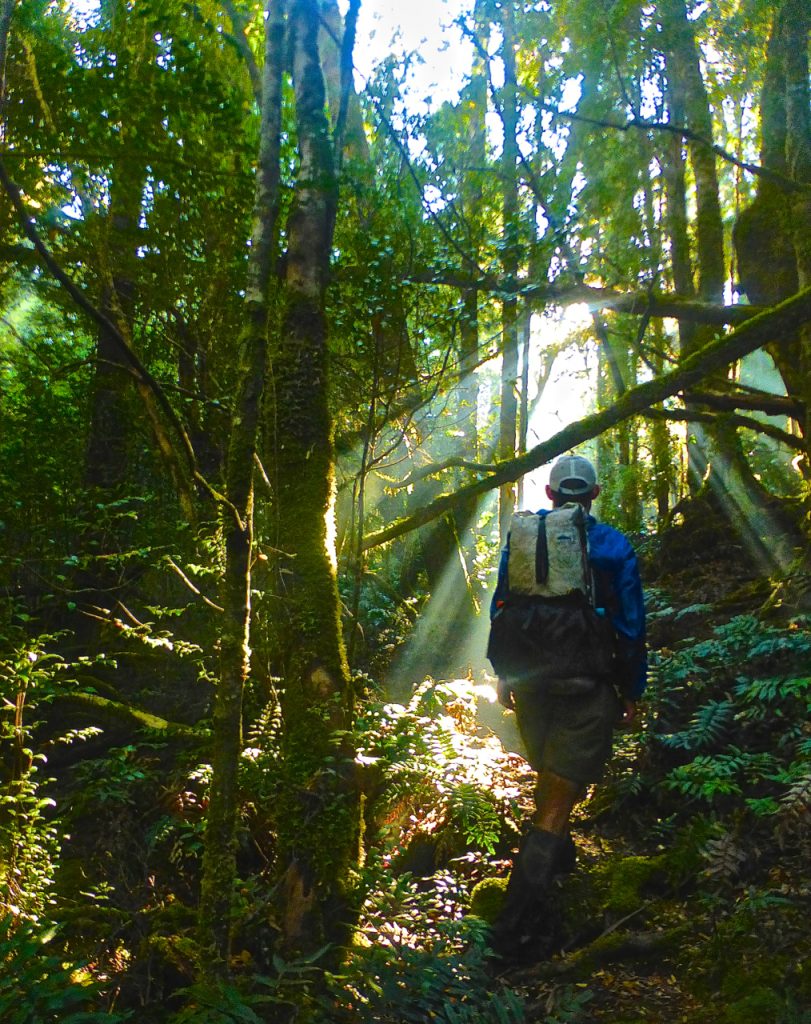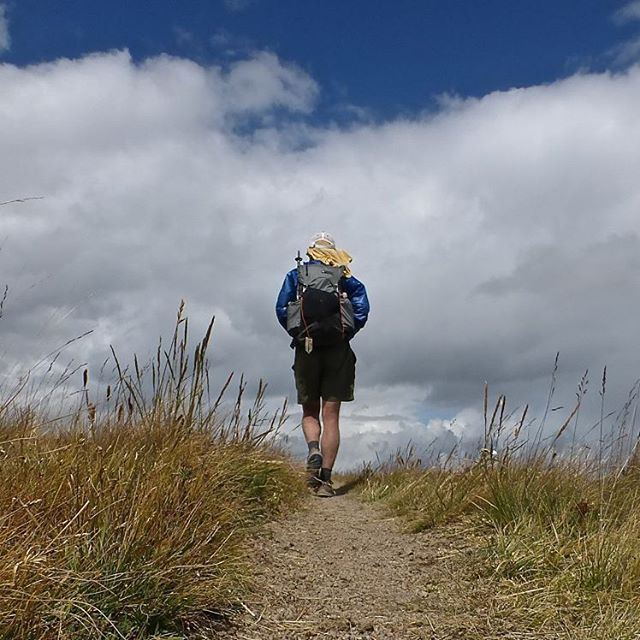Since the early 2000s, frameless backpacks have been my rucksack model of choice for the majority of hiking trips that I have done. While by no means an ideal option for all hikers and all types of journeys (see below in FAQ’s), personally speaking, I enjoy using them for the following reasons:

Frameless pack procession on the Lowest to Highest Route. (L to R): Joshua “Bobcat” Stacy (Gossamer Gear Kumo), Ryan “Dirtmonger” Sylva (Gossamer Gear Kumo), Greg “Malto” Gressel (Mountain Laurel Designs Burn).
1. Simplicity: Frameless packs generally have simpler designs. Fewer zippers, fewer compartments, fewer straps, less that can break, rip, or go wrong.
2. Fit: With frameless backpacks, it is the load itself that provides the structure. With an unrolled or folded sleeping mat acting as a makeshift frame sheet, ideally, a frameless pack should mould to the contours of your back. In order for that to happen, particular attention must be paid to the manner in which your pack is filled. A heavy load packed indiscriminately into a frameless model, will be a lot more uncomfortable than it would be in a more forgiving internal or external frame backpack.
3. Weight and Durability: Frameless packs are lighter than other models. Generally speaking, we’re talking 0.6 kg (21 oz) or less. That said, over the years I have found that the weight saving doesn’t come at the cost of durability. Case in point are the two Mountain Laurel Design Burn packs that I have owned since 2009. Each pack lasted at least 8,000 trail miles (12,874 km). The one caveat to this is if you regularly overload them, in which case the stitching tends to fail quicker than framed backpacks; particularly around the shoulder strap area.

Sometimes you just have to go big, and one of the largest loads I ever carried in the MLD Burn was during an approximately 240 mile, seven day stretch between East Glacier and Helena, MT, on the Continental Divide Trail in August 2012.
4. Size: People who buy backpacks with large carrying capacities (e.g. 65 litres or more) generally find ways to fill them. You have all that space, it would be a shame to see it go to waste, no? An inherent advantage of frameless packs is that they are generally small. They are not made to carry loads over 10 kg (22 lbs) for extended periods of time. This limitation forces the hiker to pare down their backpacking kit from the outset. With a frameless pack the focus needs to be on carrying the necessities, with superfluous luxuries either left at home or kept to a bare minimum.
5. Cost: Generally speaking, frameless models are cheaper than internal and external framed backpacks.
FAQ’s
In regards to weight, how much is too much for a frameless backpack user?
If your base pack weight is more than 5 kg (11 lb) or you regularly expect to carry a total weight of more than 9 or 10 kg (20 – 22 lb), you are better off going with a lightweight internal frame backpack. Why? In short, internal frame packs with a fixed hip belt offer superior load distribution between your shoulders and hips (i.e. they’re more comfortable to use when carrying heavier loads).

For the twenty-four day traverse of SW Tasmania, I started with a total pack weight of 19 kg (42 lb). Suffice to say I upsized to an internal framed Hyperlite Mountain Gear 2400 Southwest Pack.
Speaking of hip belts, what about the theory that they aren’t necessary for frameless backpacks if your base weight is under 4.5 kg (10 lb)?
I disagree, with the following caveat – if the majority of your hiking is done on maintained trails in three-season conditions, then yes, you can definitely get by sans hip belt without too many issues. This particularly holds true if you rarely hike for more than four or five days between resupplies (i.e. your total pack weight doesn’t exceed 10 kg / 22 lb). When hiking on such pathways, more often than not I’ll leave my hip belt loose or clip it around the backside of the pack (i.e. the same effect as a “beltless” model).
However………
I never give it the chop, because, for a weight penalty of only 1.5 to 3 oz (i.e. the equivalent of one or two Snickers bars), hip belts can make a difference in regards to load distribution, balance, and stability, particularly when hiking in challenging, off-trail conditions for extended periods.

Justin “Trauma” Lichter (the one doing the pushing) under the strain of a heavy load during the Copper Canyon Traverse (Note the hip belt!) | Mexico, 2013.
What are some Frameless Backpacks you can recommend?
Since the early 2000s, I’ve extensively used frameless packs from Mountain Laurel Designs, Gossamer Gear and Granite Gear. Another company with a long-term track record of making high-quality frameless models is ULA Equipment.
- Gossamer Gear Kumo
- Granite Gear Virga 2
- Mountain Laurel Designs Burn
- Mountain Laurel Designs Prophet
- ULA CDT

Great post. Its carrying larger quantities of water eg. desert sections of the PCT that concern me with frameless packs. How do ultralighters hike those sections comfortably with a 38L frameless/hipbeltless pack? I currently use a Nigor Zero G 49L pck 1050g that is fully featured inc. hipbelt with hipbelt pockets, durable ‘solid’ ie. non mesh front pocket plus lid/lid pocket and an internal frame. While I’m tempted by the ultralight frameless packs, I wonder if that little extra weight of a pack such as the Nigor – maybe 350g? – is worth it if it can carry large quantities of water comfortably? I realise its all horses for courses!
Hey Jay,
There are different H2O strategies you can apply while hiking in arid environments. Check out this article for some ideas: https://www.thehikinglife.com/2017/05/hydration-tips-for-hikers/
Whether or not you will be ok going with a frameless pack on the PCT desert sections really comes down to the individual. Everyone is different in regards to comfort, experience, goals, fitness, H2O needs, etc. Look objectively at all these factors in so much as they relate to yourself. If you decide to give one a try, be sure to load it up and take it out on some practice hikes before starting the PCT. See how it feels; this is really the only way you are going to know with any degree of certainty. Worse case scenario, you have yourself another pack that you can use for overnighters and/or backpacking trips where the loads will be relatively light.
All the best,
Cam
Thanks for this great article man!
If someone has some spinal deterioration with some neck issues, wouldn’t a frame pack be better at setting the weight on the hips, with less weight on the shoulders and neck? It is very important for me to get my pack weight pared down, but, I am wondering if a frame pack is worth the weight to keep the load on my hips. Or am I misunderstanding frameless distribution?
I’m not a doctor, but I’d say you are a correct; in most cases a lightweight framed pack (along with a lightweight load) would be better suited to folks with the issues you reference.
Tried leaving a reply yesterday. Not sure if it went through?
Of the 5 packs you recommended in the article is there one you prefer if the main purpose is day hikes in the white mountains or overnight to an AMC hut? I plan to hike in the French Alps, once the pandemic allows. I would like a pack that is big enough to hold a week of clothes (no shelter or sleep system), but cinches down enough to become a daypack once I arrive in the Alps.
Hi Jonathan,
Thanks for the message. They are all great packs, but my personal favourite and the one I’ve used the most over the years would be the MLD Burn. I’ve always been a fan of the slim profile, and volume-wise it should suffice for the criteria you describe.
Cheers,
Cam
Thanks Cam. That was the one I was leaning towards.
Hi Cam,
I have a question for you. I have been training with MLD Prophet on my local trail – 5.5 miles, 1000 feet of climbing with 22 to 23 lbs. Don’t use the hip belt. I have absolutely no pain during or after the hike. I do this trail 20 times in a month. It has lots of steps and I usually can run down the steps and do a slow run going up. Now as my trip for summer gets closer, I usually increase my distance for a few days to see how my body is reacting. What I find is that I have no issues during the 11 miles, 2200 feet of climbing hike – but, after I remove the backpack, I have some soreness on my upper trapezoinds – no shoulder pain. I am wondering if the soreness is due to going from 21.5 to 22 lbs on shoulder for 11 miles and then suddenly not having any weight on the shoulders. Do you ever have any soreness issues like these after you remove the backpack? No issues while hiking. I could use the hip belt I suppose and see how it is. But, just wondering if other users of frameless have experienced such issues. This soreness or tightness goes away after some time. And I am good the next day. Perhaps it is conditioning of longer distances which should go away once I hit the trail? Don’t know. Also where I train is very humid and hot – Austin, Texas. That could also be contributing to the problems. On and off I am re-thinking if I should just go to a framed pack. I am going on the SHR mid-july. Thanks!
Hi Murali,
Thanks for the message. I can’t say I’ve ever experienced the trapezoid issue you described, but I’ve definitely felt occasional tightness in the shoulder area while carrying heavier loads in frameless packs. I think your best bet is to experiment with the hip belt, and maybe even see how you feel with similar weights in a framed model. Everyone’s different. Personally, I tend to go with a frameless pack if I’m consistently carrying under 10/11 kg (22/24 lbs), and a framed pack for weights that are regularly over that.
All the best on the SHR!
Cam